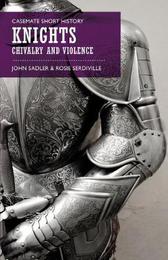
|
Knights: Chivalry and Violence
Paperback
Main Details
| Title |
Knights: Chivalry and Violence
|
| Authors and Contributors |
By (author) John Sadler
|
|
By (author) Rosie Serdiville
|
| Series | Casemate Short History |
|---|
| Physical Properties |
| Format:Paperback | | Pages:160 | | Dimensions(mm): Height 198,Width 125 |
|
| ISBN/Barcode |
9781612005171
|
| Audience | |
|---|
| Illustrations |
30 b/w illustrations
|
|
Publishing Details |
| Publisher |
Casemate Publishers
|
| Imprint |
Casemate Publishers
|
| Publication Date |
21 September 2017 |
| Publication Country |
United States
|
Description
Originally warriors mounted on horseback, knights became associated with the concept of chivalry as it was popularised in medieval European literature. Knights were expected to fight bravely and honourably and be loyal to their lord until death if necessary. Later chivalry came to encompass activities such as tournaments and hunting, and virtues including justice, charity and faith. The Crusades were instrumental in the development of the code of chivalry, and some crusading orders of knighthood, such as the Knights Templar, have become legend. Boys would begin their knightly training at the age of seven, learning to hunt and studying academic studies before becoming assistants to older knights, training in combat and learning how to care for a knight's essentials: arms, armour, and horses. After fourteen years of training, and when considered master of all the skills of knighthood, a squire was eligible to be knighted. In peacetime knights would take part in tournaments. Tournaments were a major spectator sport, but also an important way for knights to practice their skills - knights were often injured and sometimes killed in melees. Knights figured large in medieval warfare and literature. In the 15th century knights became obsolete due to advances in warfare, but the title of `knight' has survived as an honorary title granted for services to a monarch or country, and knights remain a strong concept in popular culture. This short history will cover the rise and decline of the medieval knights, including the extensive training, specific arms and armour, tournaments and the important concept of chivalry.
Author Biography
John Sadler BA (Hons) M.Phil, FRHistS, FSA (Scotl.) is an author, lecturer, battlefield tour guide and historical interpreter. He has been a visiting lecturer at the North East Centre for Lifelong Learning teaching war studies for fifteen years and has some thirty published titles in print or preparation. He is an experienced battlefield tour guide for both world wars in Europe and for a range of earlier conflicts. As a historical interpreter and partner in Time Bandits, he has appeared in a wide variety of guises in museums, galleries, schools, the community and heritage sites from Ramses II of Egypt to WWII Home Guard and Auxiliaries. He is married with two daughters and lives in mid-Northumberland. Rosie Serdiville is a writer and educator with a particular interest in radical history. She works together with John Sadler in schools and for heritage sites, often using our very different viewpoints to provide an alternative commentary on historical events. She is Vice President of the Society of Antiquaries of Newcastle upon Tyne, and co-author with John Sadler of 7 military history titles.
ReviewsIt's a really informative book which won't wear out its welcome. It whets the appetite to learn more, which is really the greatest compliment I can give it. * Army Rumour Service * I imagine that schools will find these to be useful background primers for a period of history study. * Miniature Wargames - Chris Jarvis *
|